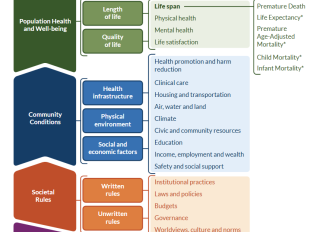Increasing energy efficiency through building retrofits
Rising global temperatures, melting polar ice, changing weather patterns, and increasing storm severity — climate change is a complex problem that requires a multifaceted approach.
One approach is retrofitting, a process that updates an existing building with modern components and technologies to make it more energy-efficient and structurally sound. County Health Rankings & Roadmaps recently published a new strategy on building retrofits towards net zero energy in the What Works for Health database. This strategy is strongly supported by evidence to increase energy efficiency, reduce emissions and combat climate change.
One way retrofits can reduce a building’s environmental impact is by using renewable energy sources such as solar, geothermal and wind. The heating and cooling efficiency of existing structures can be further improved by installing insulation, double-pane window glazing, energy-efficient doors and other measures. Building retrofits can also lead to net zero energy, meaning these buildings produce as much energy as they use or more, with low or no greenhouse gas emissions.
Implementing retrofits may also improve health equity by addressing energy burdens. Historically, the U.S. has implemented racially discriminatory housing, lending, and exclusionary zoning policies that created residential segregation. These practices have converged, resulting in redlined neighborhoods having homes with inefficient heating and cooling systems, lead paint, old pipes, mold, and other issues that also require repairs. Building retrofits that subsidize and support homes in redlined neighborhoods can reduce health disparities caused by these structural harms by lowering energy costs.
Building retrofits toward net zero energy are among the many approaches individuals and communities can take to combat climate change and address health. Find additional strategies that address climate change in the Climate Change Curated Strategy List, explore the data on adverse climate events, and learn about the climate’s relationship to health and equity.



